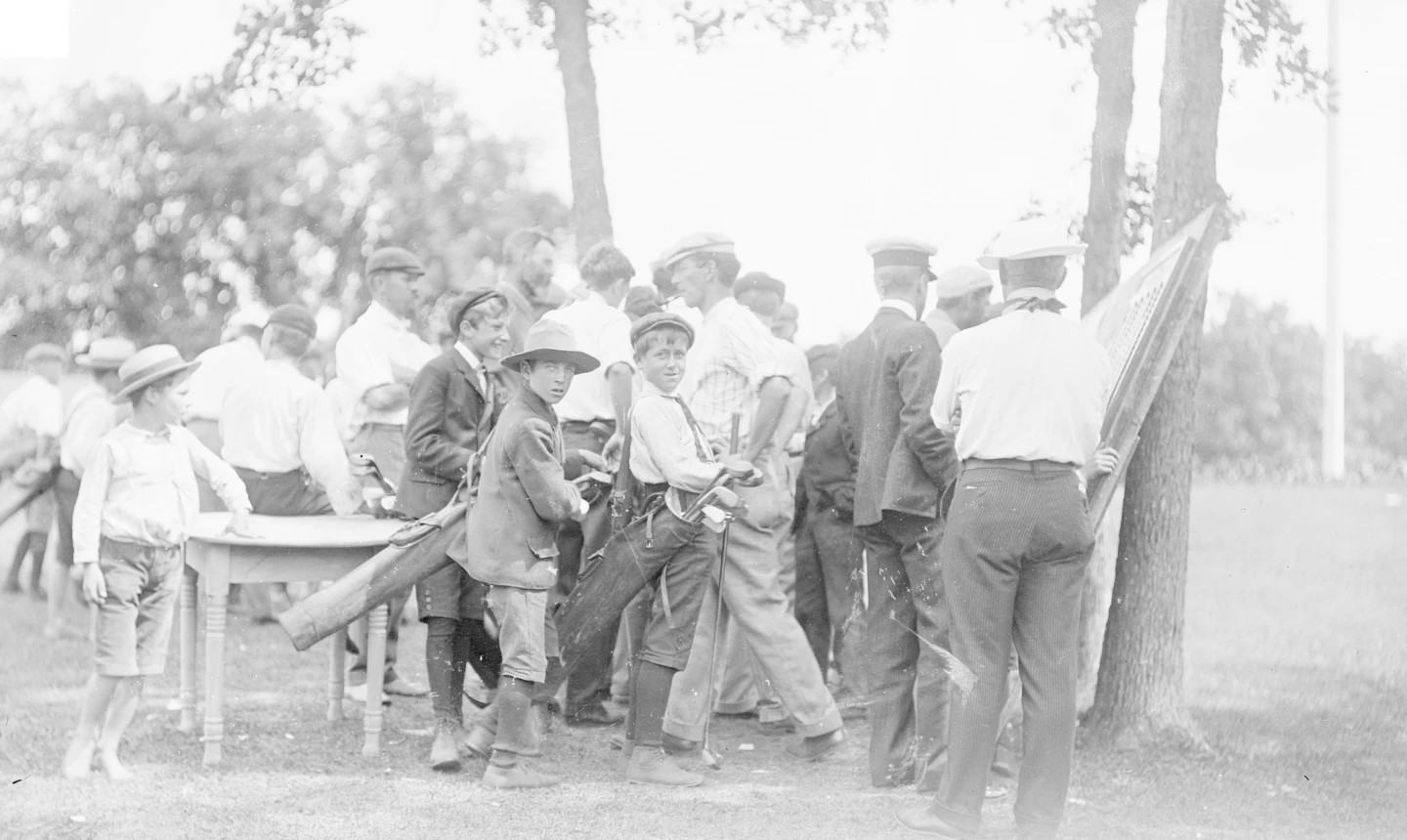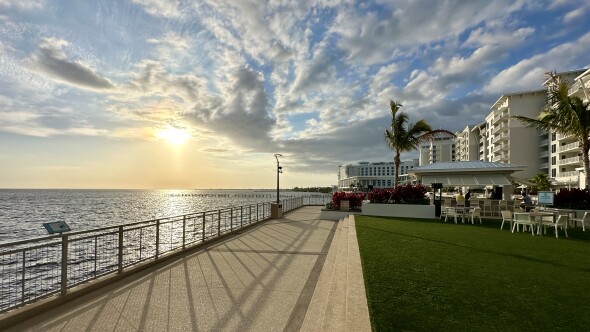They were once an indispensable part of the golf experience. Now, they have virtually faded away, limited to a relative handful of elite private clubs, some resorts and the international competitive golf circuit.
Still: “Once a caddie, always a caddie,”
That’s long been my mantra, valid in golf as in everyday life. Or at least it's the attitude I acquired on the golf course and have since applied to just about every sphere I’ve encountered, especially in the work world.
It’s a position I have been keen on since I started looping at a private club on Long Island back as a 14 year old and that subsequently strengthened through engagement as a looper during summers on the PGA Tour. It’s an attitude that has never waned and that comes out even now, decades later, during casual rounds with friends, or even people I have met on the golf course for the first time. I eye their game but also their whole attitude – not just to golf but to how they play and how they handle themselves during a round.

I’ve always thought caddying was more than about earning spending money as a kid. It was about learning how to be an adult and how to handle myself with strangers, occasionally in awkward circumstances. A bad yardage, a lost ball or a botched shot – the stuff of everyday golf provided an occasion for how I handled myself and how I responded to what my player said and did.
Did he blame me, curse me, accept it as rub of the green? Would I learn from my error, so that next time I'd be more accurate in my distances or track the ball more precisely?
The beauty of it was that it was only just about golf, with no spillover effect and no major consequences beyond the immediate round. A round as a caddie meant four hours in a laboratory of life skills, honed in a safe environment, to be tested in later life.
Tradition

The nagging question: will the caddie tradition continue? And will it ever again become embedded as one of the rites of passage for youth? It turns out that not only is caddying very good for growing the game of golf (and golf's major institutions promote this wish constantly), it's also good for training young boys and girls as they mature into adults.
There is reference to caddies dating back as far as 1691 at St. Andrews. The name of the trade appears to derive from a Scots term for a luggage handler or valet. A far more intriguing derivation traces the lineage of the term to an Anglicized version of the late Medieval French term for military “cadets” – young men training for status as soldiers in the field who carried the weaponry to battle but did not actually engage in combat. That genealogy, while suggestive, remains romantically wistful but unconfirmed if not simply untrue.
Initially, they were semi-professionals or aspiring to play for a living and earn their money through gambling on the links. Others were seasonal workers, mainly fishermen, looking to supplement their income. Among the 21 registered caddies at St. Andrews on a list that appeared around 1870 were three who would go on to win Open Championships: Thomas Kidd Jr. (1873), Robert Martin (1876, 1885) and Willie Fernie (1893). In between loops at St. Andrews, early caddies would help on the maintenance crews. Among the many jobs that Old Tom Morris held at St. Andrews was that of caddie supervisor.
By 1890, caddies at St. Andrews were enrolled in a benefits fund for those who became infirm. Their efforts that year were aided considerably by one of many technological innovations that helped shape the modern game: the golf bag, which dramatically eased the craft of handling clubs and lugging them about.
The Modern Game

America’s caddie yards are a lot quieter than they used to be. You can thank golf carts for that. Their advent as a means of transport in the 1950s was something of a shock to the caddie ranks, though clubs were initially slow to rely upon them. They seem to have developed as standard golf equipment as part of a cultural shift in a society based increasingly upon automobiles.
The widespread adoption of the powered cart as the dominant mode of conveyance during a round by the 1970s was due to their profitability. Club managers discovered that golf carts were a major source of net revenue to a golf facility's bottom line. They were also easier to manage than a caddie corps.
As state and local governments began imposing rules on youth employment and casual outdoor work like caddying, the administrative burdens of managing a caddie corps rapidly outstripped the purview of the traditional caddiemaster. Rules governing minimum wage rates, payroll taxes, disability insurance and workplace safety multiplied.
The adult members of the old caddie yard – often comprising school municipal employees seeking secondary income, plus some “lifers” who had more or less dropped out of the blue-collar labor market – also became subject to burdensome labor laws that completely changed the old golf culture. It didn’t make organizing a caddie corps impossible; just more difficult.
As long as they are priced well below caddie rates, carts will continue to be favored by the majority of golfers. Efforts to move away from them and back to caddying requires careful management strategies, as well as a willingness by golfers to pay for the privilege of being accompanied by a human being rather than a motor or electric battery.
The evolution of course design was not kind to caddies. The advent in post-World War II America of real-estate-related golf communities ended up creating long distances between holes as developers sought to maximize real estate frontage on golf corridors. Where lengthy cart paths unfold, few caddies dare tread. Not surprisingly, it’s at easily walkable, old-school routings where caddies are most likely to find secure employment.
Today, if a facility wants to make a go of having caddies, it can help having someone do the organizational work and deal not just with personnel but with bureaucracy, payroll and work rules. That’s been the appeal of a firm like Caddiemaster. The Ponte Vedra Beach, Fla.-based operation provides comprehensive training and uniformed service to many leading resorts and elite private clubs. Like everything in golf, the service comes at a cost – to the club, which pays a fee to the company, and in effect to the caddie, a percentage of whose pay goes to the company. But the caddie benefits through secured employment, plus they keep all tips in addition to a share of the base caddie fee. Interest in this side of the market is growing, as evident in the emergence of another company, CaddieNow, which is seeking to occupy a similar market space, this time with a more mobile app-oriented digital appointment service tied to client courses.
Caddie Culture

Anyone who tells you that a caddie’s job is “to show up, keep up and shut up” was either a lousy looper or a miserable wretch to carry for. The art of carrying a golfer’s bag and of properly fulfilling that role has a long history, a detailed protocol and a rich legacy, all of which extend well beyond the golf course to include crucial life skills.
Much of that learning takes place in the intimacy of the walk alongside a golfer for four or five hours during a round, and, for a professional tour caddie, five or six 10-hour days during tournament week. That’s a lot of time together, much of it wrapped in privacy, but occasionally spilling over into the public sphere for all to see and comment upon.
Nobody in any other sport is closer to the action. No one else gets to share the real-time emotions, calculus and afterthoughts of an athlete in the heat of competition. When it comes to being right in the middle of things and playing an essential part of the action, a caddie has a unique position.
In no other sport is a non-competitor right there in the action, on the field of play, able to act in a manner vital – though still clearly subordinate – to the athlete’s performance. A bat boy in baseball stays in the dugout and in foul territory, never crossing the chalk lines. In tennis, those perfectly poised teenagers and young adults standing behind the service line or alongside the net scurry on and off the court between serves and volleys, not during. A football water boy dispenses drinks and towels, not advice. A cut man in boxing does his healing between rounds, not during. Caddies are there in the trenches.

Just ask those who have been there and who have used it as launching pad for success in business, let alone in golf. Little Eddie Lowery, all of ten years old when he caddied for Francis Ouimet in the 1913 U.S. Open, parlayed that historic role astride a champion into a career that saw him own one of the West Coast's biggest car dealerships. Lowery also landed a position on the USGA Executive Committee and played no small role in an amateur golf sponsorship scandal that rocked the industry.
There’s probably no better place to get your start in business than in the caddie yard. That’s the view of veteran golf clothing executive John Ashworth, and it’s one shared by many in the corporate world as well as throughout the golf industry. Ashworth is a former caddie – as a teenager at La Costa Resort in Carlsbad, Calif.; at Tucson Country Club during his college days; and one year on the PGA Tour with Mark Wiebe.
Ashworth recalled that the caddie yard culture at La Costa was not your typical one filled with school-age kids. There were lots of middle-age people there – “ex-Marines, truck drivers. Pretty gnarly,” he said.
You grow up pretty quickly in an environment like that. “It’s unsurpassed as a means of getting to know people who are successful and well-traveled,” said Ashworth. “Caddying builds character. It can transform a kid. The people-skills it builds are underrated.”
Caddies. Bag toters. Loopers. Whatever the moniker, they have been a colorful part of the game for centuries. The game's sherpas, they have helped orient players, settled them through thickets of various hazards and obstacles, and along the way provided a level of psychological counseling that qualifies them as therapists-in-training.
Many Hall-of-Fame golf careers started there. Ben Hogan, Byron Nelson and Bernhard Langer all honed their competitiveness as young caddies before they turned pro.
Those of us who grew up in the caddie yards of American golf remember fondly the life lessons not just acquired in the company of our players, but also in the time spent hanging around waiting for a loop. This downtime has its own richness of lore and personal growth. Suburban kids who find themselves in a caddie yard with men and women from more blue-collar urban neighborhoods can learn how diverse their own community is more quickly than their peers otherwise might. That removal from a bubble of privilege can make impressionable youngsters into empathetic adults in a hurry. There is a forced intimacy that cannot be replicated in any other youthful employment.
Revival
Efforts to revive the caddie ranks these days play up its value, not just as early work experience that is positive for the game but also for the way it can shape teenagers into young adults. With a booming caddie ecosystem, golf acquires newcomers to its ranks and the game kicks into a cycle of perpetual renewal.
The understanding of the social benefits of caddying has now caught on and drives some interesting initiatives. While running his trendy apparel firm, Linksoul, Ashworth has been a driving force in the revival of a 4,470-yard, par-65 municipal layout in Oceanside, Calif., called Goat Hill Park. It's a popular place, with green fees maxing out at $50 and most of the play from locals at half that rate. Among the many attractions is the availability of youth caddies at a pretty good rate: free to the golfer, though tipping is encouraged.
The name of the program is as large as its ambitions: the North County Junior Golf Association Caddie and Leadership Academy. It’s a summer program, with about two dozen participating this last year. Naturally, golf plays a big part in the workshops and activities designed to groom youths for adulthood. Caddying is part of the deal, with participants issued a check at the end of the season based upon how active they were. Plus, they get to keep those tips. Besides teaching youth the virtues of hard work, the NCJGA helps give municipal golfers an experience that they probably would not otherwise indulge: having someone caddie for them.
A forerunner of the program at Goat Hill can be found at CommonGround Golf Course in the Denver suburb of Aurora, Colo. The public access course, designed by Tom Doak, is privately owned by the Colorado Golf Association and run at affordable rates, with junior golf encouraged. Among the programming there is the Solich Caddie Academy, funded by the Solich Foundation and named after two brothers, George and Duffy, who caddied at local clubs before becoming successful businessmen. Now, it’s their turn to do something for the community through golf.
This is the program’s eighth year, and it comprises 18 youths, 13-15 years old, who attend classes on financial literacy and community leadership on Mondays during the summer while they make themselves available to caddie at CommonGround. Cost to golfers is zero, though, as at Goat Hill Park, they can tip as desired. This past summer, almost 1,000 caddie rounds have been recorded, and those who completed the requirements (including 36 rounds looping) received a check for $1,200, plus the tips they earned along the way. They also learned basic work skills, like showing up alert at 6 or 7 in the morning.
After years of decline, these programs provide evidence of a renewal, both in terms of the caddie ranks and in the interest of the golf industry in promoting the practice. Olympia Fields Country Club south of Chicago, once home to 1,000 caddies back in the 1920s when it had four 18-hole courses, now has a crew of 300 loopers at the 36-hole facility. Rates are modest enough to encourage widespread use, with caddie fees ranging from $25 to $45 per round, depending upon rank, plus tip. About 30 percent of the club’s rounds are under tow. It helps that the club’s two courses are routed in classic walkable fashion.
Industry-wide details on caddie ranks are notoriously lacking. That’s a reflection of the golf business, which by nature is decentralized. But one facility that is surely at the center of a revival in the art of caddying is Bandon Dunes, the coastal Oregon resort with four 18-hole courses in operation, a fifth course in the 13-hole, par-3 Preserve, plus a full-scale 18-hole layout, currently under construction. There we find 300-350 caddies affiliated with the resort property and involved in about two-thirds of all rounds - some 75,000 caddie rounds a year. Fees for a bag are suggested at $100 per plus tip, with $125-$130 now standard, and fees about half of that for the 13-hole Preserve. The crew there runs the gamut in age, including local high schoolers that are thinking beyond Coos County for college.
In addition to earning money, youth today can also look forward to help from golf associations when it comes to meeting college costs. Many state and regional associations have created caddie scholarship programs and rely upon member clubs to contribute. Case in point: the Long Island Caddie Scholarship Fund, founded in 1962, has seen participation by half of the 160 golf courses in the region. Last month the LICSF made 51 new scholarship awards, its largest class ever. For the first time, it had more applicants than awards to give out. The program currently has 131 awardees in college, receiving a total of $286,000 in direct grants.
The country’s regional caddie scholarship programs all pale in comparison to the largest, most well funded of them all, the Western Golf Association’s Evans Scholarship Foundation. It dates to 1930 and was originally focused on Chicagoland but now encompasses the country with its network of participating courses.
Evans Scholars, as they are known, are now enrolled at 18 major universities across the country, including Penn State, Washington, Kansas, Michigan, Notre Dame and Marquette. There they receive full tuition and housing.
The new class of Evans Scholars numbers 280, the largest ever. That brings the total active ranks to 1,010 enrolled, at a cost of $24 million.
The total alumni class of 10,830 Evans Scholars is a tight-knit group whose links extend well beyond the college dorms to include business and social networking for a lifetime. And it all started with caddying. Among those who have participated in the Evans Scholars are 19 graduates of the Solich Caddie Academy at CommonGround.
Professionalization

The public is certainly seeing more news about caddies on the major golf circuits. It is now standard for the networks and cable channels to be outfitted with lists of the caddies working for every player in the field. News coverage increasingly focuses on the player-caddie relationship. One of the real veterans of the Tour caddie yards, Jim “Bones” Mackay, has parlayed his knowledge and name-recognition from a quarter-century as Phil Mickelson’s caddie into a leading role as a golf commentator with NBC Sports.
Mike “Fluff” Cowan, a PGA Tour caddie stalwart since the mid-1970s for the likes of Ed Sabo and Peter Jacobsen, became a star in his own right with his TV commercials when he was Tiger Woods’ caddie, 1996-1999. His departure became big news, as did the conspicuous way in which his successor, Stevie Williams, gruffly handled crowds and the media during his tenure as Tiger’s bagman from 1999 to 2011.
It’s not just celebrity caddies who are getting all the attention these days. Not, at least, if the folks at The Caddie Network can help it. The startup business combines a web media presence with an ambitious business model to highlight and promote the efforts of professional loopers on the PGA, LPGA and European Tours.
John von Stade, co-founder of the enterprise, grew up caddying and has always been around sports marketing. Now his efforts are focused, he says, “on giving a credible voice to the profession of caddying. We want to give golf fans a different perspective on the pro tours and on the value of caddying.”
To that end, 160 caddies have signed on, most of them from the PGA Tour, with a 10-year licensing agreement with the Association of Professional Tour Caddies, who have a partnership with The Caddie Network. Between a news presence, feature writing by and about Tour caddies and commercially oriented deals with sponsors, the nascent media property seeks to highlight caddying as both a business and a lifestyle.
“She made me laugh while I was playing bad golf... not many people can do that.” - @chambleebrandel talks to @JohnstonGarrett about what it was like having his wife, @BaileyMosierGC, on the bag at last week's @ChampionsTour event. https://t.co/AWVNOim5Qg
— Caddie Network (@CaddieNetwork) September 3, 2019
One place they will not go is caddie pay. That’s the third rail of golf. Caddie salaries on Tour are legendary for remaining secret, even among peers.
But sometimes, issues break out into the open, and then the golf public gets a look inside what is normally kept as a private relationship.
Such was the case earlier this year, when Matt Kuchar was reported to have stiffed his caddie after winning $1.296 million in the 2018-19 Mayakoba Golf Classic Mexico. By Tour lore, a winning caddie’s share is ten percent, but by prior agreement with his temporary caddie for the week, a local by the name of David “El Tucan” Ortiz, Kuchar paid out only $5,000. The matter became public and turned ugly as Kuchar hesitated to respond, then stubbornly defended his action, then relented and finally paid Ortiz $50,000 – still “only” 3.8%, but a lot better than before. What it cost Kuchar in public relations goodwill, however, was incalculable.
The lesson, as any golf traditionalist can tell you, is to treat your caddie well. Or, to be more precise, treat your caddie like you would treat your own kids. Caddies, after all, are here to stay. Maybe not to the same degree as before, but they are not going away. Nor is their influence on golf's culture and history.
Bradley S. Klein is a 2006 inductee into the International Caddie Hall of Fame. He has caddied at every level of the game – private clubs, the PGA Tour, at St. Andrews and occasionally at course openings. In 1971 he was an awardee of the Long Island Caddie Scholarship Fund.












Hi everybody reading this, can someone kindly shed some light on how a club committee should go about establishing caddie fees? Is their any math etc behind or do clubs just play it by ear and charge what everyone else is charging?
I'm lookin for a certain Brad who amused a beautiful young American mother & wife named Andrea in the South of Maroc a desert a resort a
mirage Is it you Brad?
Sorry, that was not me. Never been there.
10 years ago, I spent a year caddying at May River in Bluffton, SC with Caddiemaster. Such a fantastic experience, from the initial vetting process, to the on course training, to the safety meetings, to integrating with fellow caddies and resort guests. Great fun and professionally managed. You're outside with the game you enjoy, getting a great workout and getting paid. I hope to do it again one day.
Best times of my life!! Started being a looper/ bag rat at the age of 16 at The Pepper Pike Club in Cleveland, Oh. The caddie master at the time was a tough yet fair man named Ernie. If you were on his good side you loved him like a father, if you screwed up a loop, or did something he did not like, you were told stay home for a couple of days or given the Big 4 loop(4 members with the combined age of 320!!) We were allowed to play on Mondays, but you had better be done by noon(not 12:05!!) I learned every cuss word, and listened to older caddies tell their stories from the night before!! Our caddy yard was filled with some great nicknames, the rat, blindman, hot dog, iron legs and terrible tempered Terry.(me) Looking back on those days brings back a flood of memories and a smile on my face. When I turned 21 it was time to get a real job, now I am a P.G.A. Professional. Funny how things work out.
Check out www.caddieschoolforsoldiers.com
Another aspect of development for soldiers trying to get back to a normal reality.
Dick McDermott
Great article, it sounds like my childhood! All the aspects of growing up are all so true that everyone who has not looped, should have to read this. The value of being a looper is—- Priceless!!
Great Story Bradley and proud to be in the Hall of Fame with you sir.... HOF committee is Seeking nominations for the HOF - Male & Female - Keep up the great work and Please open our links to see our heartbeat to help the Kids, Veterans & Grow the game ---
SEE> http://denniscone.brandyourself.com/
The simple fact is that with the cost of the golf itself - having a caddie makes it a very pricey round.
No mention of Dennis Cone, who founded the Professional Caddy Association and the Caddy Hall of Fame at World Golf Village. Now part of the Western Golf Association. No one has done more for caddies. I had the honor of serving on the original Board along with Jan Stephenson.